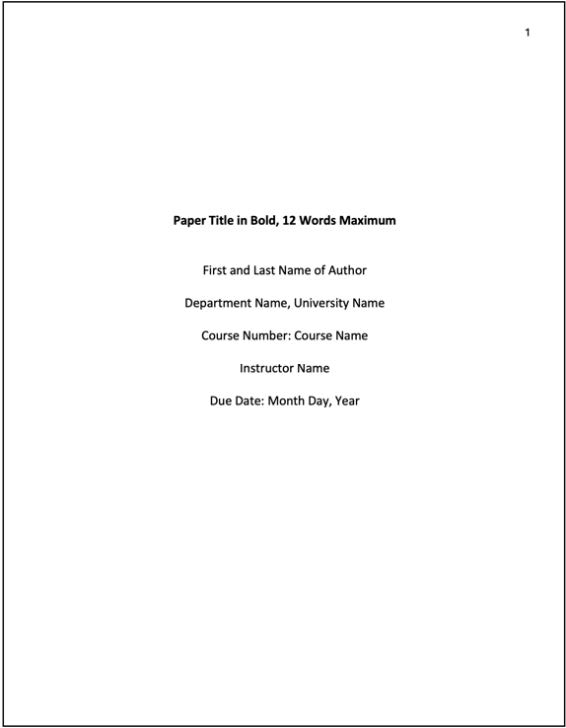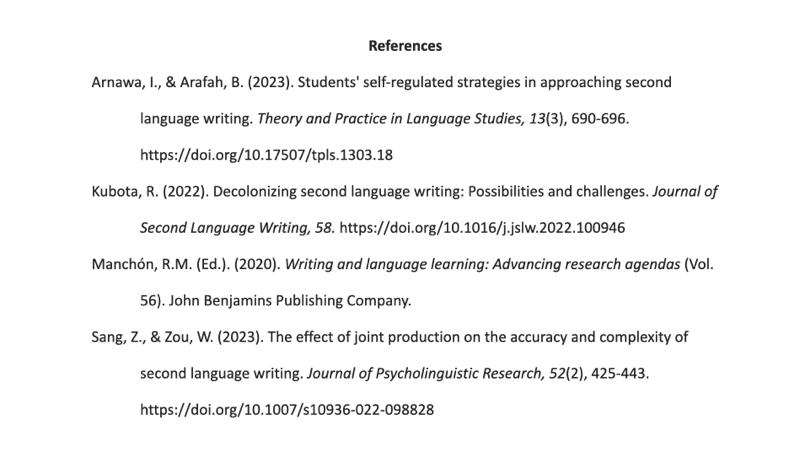American Psychological Association (APA) style is used in various fields of study, including social sciences and medicine, which prioritize the use of recent sources. Like most citation systems, APA requires specific formatting and both in-text and full reference citations. In-text citations help readers distinguish between the writer’s work and ideas from other sources. Corresponding reference citations help readers locate those sources. Properly citing sources helps writers establish credibility and avoid plagiarism. While this handout covers APA formatting and citations, writers should customize their work for their specific audience and assignment. Note that section numbers provided in this handout refer to the APA Manual (7th ed).
The title should reflect the paper’s main idea and should be in title case, bolded, centered, and positioned in the upper half of the page. Add a blank line, then write your name, department and university name, course, instructor, and due date (in Month day, year format), each on a new line. Double-space the entire page.

Although APA encourages writers to have an abstract, many professors do not require one. An abstract is a summary of the paper’s contents, typically no more than 250 words. Abstracts are placed on their own page in paragraph format with no first line indentation. Abstracts are typically followed by a list of 3-5 keywords.
The first page of text includes the paper’s title. The title is bolded and centered at the top of the page, and the main text follows.
Tables and figures allow authors to present a large amount of information efficiently. APA gives the following guidelines for formatting tables and figures:
Example: The data confirms this finding, as shown in Table 1.
Table 1
Descriptive Statistics for Swimming Distance in Meters by Dog Breed
| Breed | M | SD | Range |
|---|---|---|---|
| Boykin Spaniel | 41.3 | 8.6 | 28.1-65.3 |
| Newfoundland | 39.2 | 8.1 | 36.3-42.1 |
| Standard Poodle | 34.7 | 9.2 | 29.7-41.4 |
Note. All swimming occurred in a pool with breeds measured separately (n=25 per breed)
Headings help organize the text for readers. The number of heading levels needed for a paper depends on its length and complexity. Most student papers use between one and three heading levels. Headings use the same font and font size as the body text and are formatted as shown below:
Level 1 Heading: Centered, Bolded, Title Case
The paragraph begins here as a new indented paragraph.
Level 2 Heading: Flush Left, Bolded, Title Case
The paragraph begins here as a new indented paragraph.
Level 3 Heading: Flush Left, Bolded, Italicized, Title Case
The paragraph begins here as a new indented paragraph.
Level 4 Heading: Indented, Bolded, Title Case, Ending with a Period. The paragraph begins immediately following the heading and continues on as regular body text.
Level 5 Heading: Indented, Bolded, Italicized, Title Case, Ending with a Period. The paragraph begins immediately following the heading and continues on as regular body text.
When summarizing, paraphrasing, or quoting words or ideas that are not your own, credit the original source or author(s) using in-text citations. In-text citations include the last name(s) of the author(s) and year of publication. Direct quotes are contained in quotation marks, and the accompanying in-text citation includes a page number with p. indicating the information comes from a single page, or pp. indicating sourced material covers multiple pages. When using sources, remember that APA discourages extensive quoting.
A narrative citation mentions the author within the sentence, so their name is excluded from the parentheses. In a parenthetical citation, the author is not mentioned in the sentence, so their name appears in the parentheses. End-of-sentence punctuation comes after the parentheses.
| Number or Type of Author(s) | Narrative Citations | Parenthetical Citations |
|---|---|---|
| One Author | Moon (2022) | (Moon, 2022) |
| Two Authors | Baker and Lee (2018) | (Baker & Lee, 2018) |
| Three or More Authors | Jones et al. (2021) | (Jones et al., 2021) |
| Abbreviated Groups, First Citation | Veterans Affairs (VA, 2009) | (Veterans Affairs [VA], 2009) |
| Abbreviated Groups, Additional Citations | VA (2009) | (VA, 2009) |
| Non-Abbreviated Groups | Mayo Clinic (2020) | (Mayo Clinic, 2020) |
If a source does not have information about the author or the author is unknown, include the title in place of the missing author(s). Italicize the title if it is italicized on the reference page. Otherwise, put quotation marks around the title. Titles may be shortened to the first few words for the in-text citation.
If a source does not have a date, use n.d., which is short for no date, in place of the date.
When directly quoting a source without page numbers, provide another way to locate the quoted information (e.g., a section heading or a paragraph number). If the source doesn’t provide a section heading or paragraph number, count the paragraphs manually.
When citing multiple sources in the same section of a paper, list sources in alphabetical order, and separate them using semicolons. This format is commonly used when synthesizing sources.
APA suggests only providing an in-text citation for information shared in a class or received via personal communication (conversation, email, interview) since the communication cannot be accessed by others.
A direct quote of 40 words or more is formatted as a block quote. Block quotes do not use quotation marks and place final punctuation before the in-text citation. Block quotes are indented 0.5 inches from the left margin. APA recommends that writers use block quotes sparingly.
Rausch et al. (2006) concluded the following: A mere 20 min of these group interventions was effective in reducing anxiety to normal levels . . . merely 10 min of the interventions allowed [the high-anxiety group] to recover from the stressor. Thus, brief interventions of meditation and progressive muscle relaxation may be effective for those with clinical levels of anxiety and for stress recovery when exposed to brief, transitory stressors. (p. 287)
When citing a source found within another source (secondary source), APA recommends finding and citing the original source. However, if the original source cannot be located, use the phrase “as cited in” in the intext citation to indicate the material is referenced from the secondary source.
While in-text citations indicate what information is borrowed from a source, citations on the reference page provide readers with all the information needed to locate sources.
For a reference list, follow these guidelines:

Author information is formatted with each author’s last name listed first, followed by a comma, the author’s first initial(s), and a period. Subsequent authors follow the same format with an ampersand (&) before the final author. Note that organizations or corporations can function as authors.
Format dates in the following order: year, month day. Omit missing months and/or days. If the year is missing, use n.d. to indicate no date.
When referring to sources that can stand alone (e.g., books, websites, films), italicize the title and capitalize in sentence case (only the first word and proper nouns are capitalized). Generally, for sources within a larger work (e.g., an article in a journal or newspaper), list the source title using sentence case, then capitalize and italicize the title of the larger source using title case (all words are capitalized, except 1–3 letter conjunctions, prepositions, and articles). If there is no title, describe the work in brackets. (Note that chapters in an edited book do not follow this pattern of capitalization.)
When citing periodicals (e.g., journals, newspapers, etc.), italicize volume numbers, place issue numbers in parentheses directly after the volume without a space, and list the page range or article number last.
To cite editors of a collection, add their names after the first title. Start with the word “In,” give the editor(s)’ name(s), then a comma and the title of the work. Use “Ed.” for one editor and “Eds.” for multiple editors.
For editions or volumes of a book, add (# ed., Vol. #) in parentheses after the title.
For frequently updated sources (e.g., social media or online maps), provide an access date. After the word Retrieved, add the date (Month Day, Year), a comma, the word from, and the URL or DOI.
A Uniform Resource Locators (URL) is a website address that may change. A Digital Object Identifier (DOI) is a stable repository for sources. DOIs are preferred over URLs, and if text will be published or read online, links should be live, so readers can easily access the referenced source.